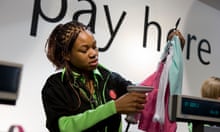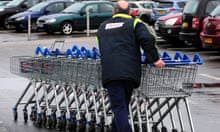Following the reopening of the UK’s retail and hospitality sectors through June and July, there were hopes that the economic damage of the coronavirus pandemic could be lessened.
But research from the Local Data Company shows that, as of July, 29% of English high street shops hadn’t reopened in the weeks after lockdown relaxation – with that proportion increasing to as much as 54% in some areas.
The findings point to inner cities struggling as lockdown was lifted, with vast swathes of London lying quiet, restaurant chains and shops announcing closures and thousands of high streets jobs having already been lost.
The University of Oxford Covid-19 Impact Monitor also shows that footfall on high streets has struggled to return to pre-lockdown levels, with visitors to inner-city areas down by half at the start of August. Tourists have helped boost footfall in some seaside towns recently, but these areas are still facing shop closures.
While inner-city areas and those that rely on tourism were among the hardest-hit in July, other areas were less affected, relying on a stay-at-home local community to sustain the high street.
By visiting areas of London, the north-west and Cornwall on a day between 10 and 20 July and counting which properties were open, researchers were able to ascertain which areas and sectors were struggling most in the immediate wake of the first wave of the coronavirus pandemic.
Spinningfields, Manchester
Manchester’s commercial office area of Spinningfields is home to Manchester crown court, banks such as Barclays and HSBC and a cluster of restaurants that serve the area’s high number of office workers.
Before lockdown, Spinningfields had a local economy catering for its office workers: restaurants, bars, pubs and health and beauty outlets were common in the area
During lockdown, almost all of the area's outlets closed as office workers were asked to work from home. A handful of banks and food shops remained open
But even with hospitality now able to open, many workers still haven’t returned to the office, leaving demand for Spinningfields’ restaurants and bars down. Footfall in Spinningfields is half that before lockdown. Overall, just 58% of its outlets had reopened as of 10 July, including 62% of restaurants
Sale, Greater Manchester
In contrast, Manchester’s commuter town of Sale had a reopening rate of 88% as of 20 July. Such a high figure within two weeks of lockdown being lifted points to the importance of a large stay-at-home community who will visit their local high street and bolster local economies.
The mix of outlets on Sale’s streets is more diverse than Spinningfields, with hairdressers, fast food and household supplies being more common.
These outlets did close as lockdown forced hundreds of Sale’s shops to shut
But, once restrictions were lifted, all of these outlets saw reopening rates at about 90%.
Even with its fashion, charity and transport outlets suffering lower reopening rates, Sale’s high street fared much better than Spinningfields’ in July
Ealing, London
London is also suffering from the same inner-city desertion as Manchester. While research from the Local Data Company shows that central London areas have low reopening rates, areas further out have benefited from people staying at home and enjoying their local communities.
Ealing, a zone 2 area which is home to many commuters, had a reopening rate of 88% as of 17 July. This compares favourably to Earl’s Court, nine stops into town from Ealing Broadway, where 41% of shops are yet to reopen.
The commuter area of Ealing has a similar spread of outlets to Sale, with health and beauty and restaurants being popular in the area
During lockdown, 22% of its outlets remained open. This is mostly because of a high number of food shops and chemists
But once non-essential retail opened, the area enjoyed a reopening rate of 88%. Sixty-nine health and beauty shops — the most common outlets on the high street — opened alone
St Ives, Cornwall
Data from the Oxford Covid-19 Impact Monitor shows that almost three times as many visitors are vsiting St Ives as at the start of March. But this rise in tourists looking to enjoy a staycation doesn’t tell the whole story, with many of the town’s shops having not immediately opened after July’s relaxation of restrictions.
St Ives relies heavily on a hospitality sector serving large numbers of tourists looking to enjoy the Cornish coast. Alongside these outlets, it also had a high number of shops selling books, arts and crafts, food and fashion before lockdown
Local Data Company researchers found that just 9% of outlets were open during lockdown in the seaside town of St Ives
But the reopening rate had recovered to 77% as of 14 July — lower than Sale and Ealing. While all food shops were open again, shops selling books, clothing and beauty services weren't doing so well.
There are, however, hopes that the return of British tourists to the area can help boost the local economy again
Kendal, Cumbria
In further proof that local communities are essential in helping areas bounce back, the north-west market town of Kendal had one of the strongest reopening rates seen by the Local Data Company, with 87% of its outlets open as of 17 July.
Like Sale and Ealing, Kendal’s mix of shops points to a local community that relies on the high street. Health and beauty, cafes and clothing shops were the most popular outlets before lockdown
When lockdown hit, over 300 shops closed, leaving just 68 open — mostly catering for health, food and medicine
After lockdown, 87% of shops were open in Kendal — much higher than St Ives’ rate. While both rely on tourism, Kendal has a greater diversity on the high street, which has enabled it to bounce back more strongly
Lucy Stainton, head of retail and strategic partnerships at the Local Data Company, said: “Evidence from our initial research shows a real contrast between locations where people live and areas where people work. This might be unsurprising given many office workers are still opting to base themselves from home thereby decimating footfall in inner-city locations. However, these are incredibly important economic hubs and so what happens next will be critical.
“Going forwards, the outlook for these urban centres remains very uncertain as we can expect most office workers to remain at home for the coming months, at least part-time, which will continue to significantly depress footfall across these locations. This coupled with the inevitable contraction in discretionary spend that comes with a recession will exacerbate the challenges city centres and fashion-retail hubs will face, especially when you factor in the higher rents these areas often demand.
“On a more positive note, we have already seen local markets get a boost from higher activity levels from home workers and a local catchment which is unwilling to travel too far. This, at least in the short to medium term is where the opportunities lie for our retailers, finding ways to serve a local population facing the fall-out from such an unexpected and unprecedented global event.”
Methodology
The Local Data Company visited each of these five areas before lockdown (as at March 2020), during lockdown (based on government guidance from 23 March on what could remain open and desktop research from company websites in March/April 2020), and after lockdown (in July, after the easing of restrictions on 4 July). In each case, a team of field researchers visited known shops in their database to assess whether they were open or closed. This analysis was then able to produce a snapshot of each area’s reopening rates at any given time.
Footfall data was computed by the Oxford Covid-19 Impact Monitor by processing location data from the Local Data Company and Cuebiq’s mobile phone location data. They first map out the locations and then, using anonymised mobile phone location data, determine when users stop for more than five minutes in a particular store. If a user stops for more than five minutes within 100 metres of a store, they are treated as having visited that place. The Cuebiq data underlying the footfall analysis by the Oxford Covid-19 Impact Monitor contains billions of visits to locations. This first-party data is collected from users who have opted-in to provide access to their location data anonymously, through a GDPR-compliant framework.









